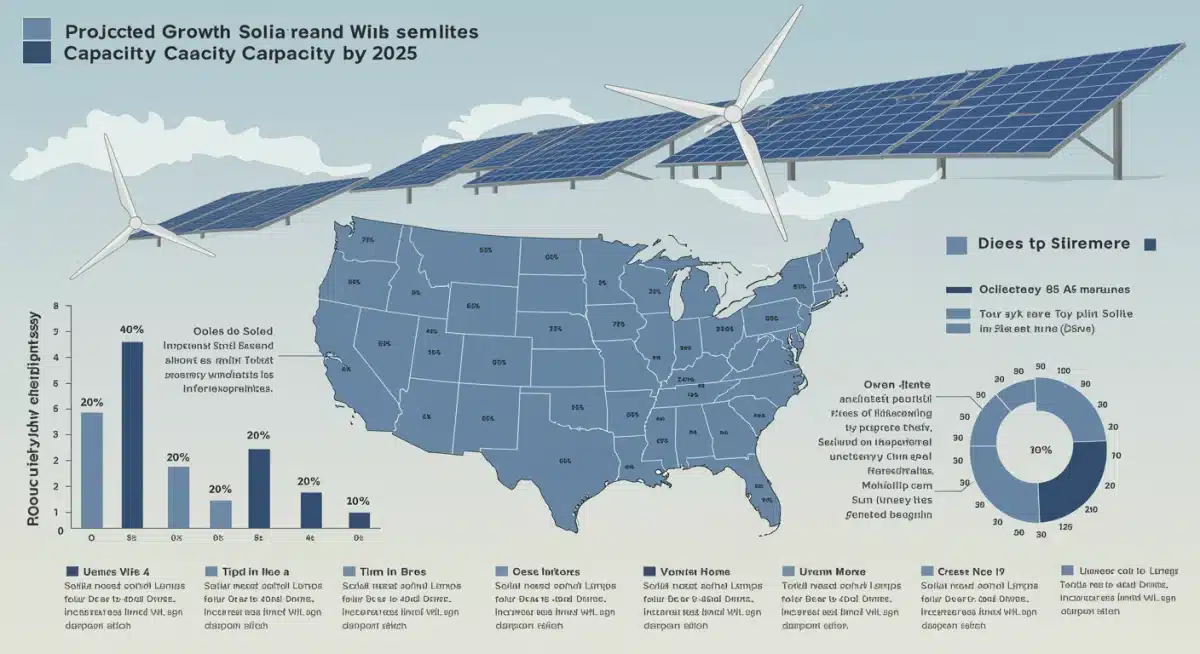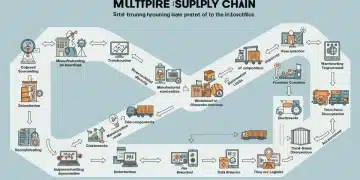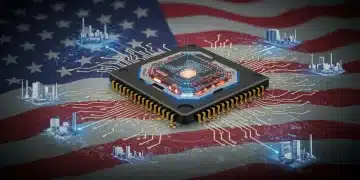2025 Energy Market: Renewable Shifts & US Grid Impact

The 2025 energy market anticipates two significant shifts in renewable adoption, forecasted to impact US grids by 10%, marking a pivotal moment for the nation’s energy future.
As we approach 2025, the energy landscape is on the cusp of transformative change. Experts are now keenly anticipating 2025’s energy market: 2 major shifts in renewable adoption and their 10% impact on US grids, promising to redefine how power is generated and distributed across the nation. These developments are not just incremental; they signal a fundamental reconfiguration of our energy infrastructure.
Accelerated Solar Deployment and Storage Integration
The first major shift emerging in analysis for the 2025 energy market is the unprecedented acceleration of solar power deployment, coupled with significant advancements in energy storage integration. This dual-pronged development is set to dramatically alter the renewable energy mix, moving beyond mere generation to more stable and reliable power delivery.
Recent reports from the Department of Energy indicate a projected 15% increase in utility-scale solar installations by the end of 2024, paving the way for an even more aggressive expansion into 2025. This rapid growth is largely fueled by technological efficiencies and decreasing costs, making solar an increasingly attractive option for both large-scale projects and distributed generation.
Technological Leaps in Photovoltaics
Technological innovations in photovoltaic (PV) cell efficiency are reaching new heights. Manufacturers are consistently breaking records for energy conversion rates, meaning more power can be generated from smaller footprints. This is critical for urban areas and locations with limited available land.
- Perovskite solar cells showing promise for next-gen efficiency.
- Bifacial modules gaining traction, capturing sunlight from both sides.
- Improved manufacturing processes reducing overall panel costs.
The Rise of Grid-Scale Battery Storage
Crucially, the intermittency challenge of solar power is being addressed head-on with the rapid scaling of grid-scale battery storage solutions. Lithium-ion batteries continue to dominate, but emerging technologies like flow batteries and solid-state alternatives are also seeing increased investment and pilot projects. This ensures that solar-generated electricity can be stored and dispatched when needed, significantly enhancing grid stability.
According to the Electric Reliability Council of Texas (ERCOT), battery storage capacity is expected to nearly double in their service area alone by late 2024, demonstrating a clear trend toward robust storage solutions across various US regions. This integration is vital for achieving the projected 10% impact on US grids by 2025, as it allows for better management of peak demand and supply fluctuations.
Offshore Wind Expansion and Transmission Upgrades
The second pivotal shift concerns the substantial expansion of offshore wind energy capacity, complemented by critical investments in transmission infrastructure. This represents a strategic move to harness powerful, consistent winds in coastal regions, delivering large volumes of clean energy to densely populated areas.
Federal and state initiatives are actively supporting numerous offshore wind projects along the Atlantic and Pacific coasts. Projects like Vineyard Wind 1 are already delivering power, with many more in various stages of development and construction, indicating a clear trajectory for significant contributions to the national grid by 2025.
Unlocking Coastal Wind Resources
Offshore wind farms capitalize on stronger, more consistent wind speeds compared to their onshore counterparts, leading to higher capacity factors. This makes them exceptionally valuable for base-load renewable power generation. The sheer scale of these projects means they can power hundreds of thousands of homes, a crucial factor in their anticipated impact.
- Northeast states leading the charge with ambitious offshore wind targets.
- Technological advancements in turbine size and efficiency.
- Floating offshore wind platforms opening up deeper water sites.
Modernizing Grid Transmission for Renewables
The influx of offshore wind power necessitates significant upgrades to the existing transmission grid. New high-voltage direct current (HVDC) lines are being planned and constructed to efficiently bring power from remote offshore locations to load centers. These upgrades are not just about capacity but also about resilience and smart grid integration.
The Biden administration’s infrastructure plan includes substantial funding allocations for grid modernization, with a specific focus on projects that facilitate renewable energy integration. This forward-looking investment is essential to ensure that the increased renewable generation can be effectively transmitted and utilized across the US grids, contributing to the overall 10% shift.
Regional Impacts and Economic Opportunities
These two major shifts are not uniform across the United States; their impacts will manifest differently in various regions, creating distinct economic opportunities and challenges. Understanding these localized effects is key to appreciating the full scope of 2025 Energy Market Shifts.
The Northeast and Mid-Atlantic regions, for example, are poised to benefit significantly from offshore wind development, leading to job creation in manufacturing, installation, and maintenance. Simultaneously, states in the Sun Belt will continue to see a boom in solar energy, attracting investment in related industries and fostering local energy independence.

Job Creation and Local Economies
The expansion of both solar and offshore wind sectors is projected to generate a substantial number of new jobs. These range from highly specialized engineering roles to construction, operations, and maintenance positions. Local economies near project sites are expected to experience a boost, with increased demand for services and local supply chains.
According to a recent report by the American Clean Power Association, the renewable energy sector already supports over 440,000 jobs in the U.S., a number projected to grow significantly as these 2025 shifts materialize. This economic stimulus is a critical byproduct of the transition to cleaner energy sources.
Investment and Infrastructure Development
The capital investment required for these renewable projects and associated grid upgrades is immense, attracting both domestic and international investors. This influx of capital drives innovation and encourages further development of sustainable energy technologies. The development of new ports and manufacturing facilities specifically for offshore wind components is a prime example of this infrastructure investment.
States are actively competing to become hubs for renewable energy manufacturing and services, offering incentives and streamlined permitting processes. This competitive landscape further accelerates the pace of adoption and ensures the continued growth of the renewable energy sector, directly contributing to the anticipated 10% impact on US grids.
Grid Modernization and Resilience Challenges
While the benefits of increased renewable adoption are clear, the integration of these new energy sources also presents significant challenges for grid modernization and resilience. Ensuring a stable and reliable power supply as the energy mix evolves requires sophisticated planning and technological solutions, particularly regarding the 2025 Energy Market Shifts.
The intermittent nature of solar and wind power demands advanced grid management systems that can forecast generation, manage load fluctuations, and rapidly respond to changes. This involves not only physical infrastructure upgrades but also the implementation of smart grid technologies and artificial intelligence for optimization.
Enhancing Grid Flexibility and Stability
To accommodate the higher penetration of renewables, grid operators are focusing on enhancing flexibility. This includes measures like demand-side management, where consumers are incentivized to shift their energy consumption to periods of high renewable generation, and the deployment of fast-acting ancillary services from energy storage and flexible generation units.
- Advanced forecasting models for renewable energy output.
- Increased deployment of smart inverters for grid support.
- Development of virtual power plants (VPPs) aggregating distributed resources.
Cybersecurity and Physical Resilience
As the grid becomes more digitized and interconnected, cybersecurity risks also increase. Protecting critical energy infrastructure from cyber threats is paramount to maintaining reliability. Alongside this, physical resilience against extreme weather events, which are becoming more frequent, requires robust design and proactive maintenance strategies.
The North American Electric Reliability Corporation (NERC) is continuously updating standards and guidelines to address these evolving threats, emphasizing a multi-layered approach to security for grid operators. These efforts are crucial to safeguarding the integrity of the US grids as they undergo significant transformation by 2025.
Policy and Regulatory Landscape
The success of these renewable energy shifts and their impact on US grids are heavily influenced by the prevailing policy and regulatory landscape. Government incentives, regulatory frameworks, and international agreements play a critical role in shaping investment decisions and deployment timelines for 2025 Energy Market Shifts.
At the federal level, tax credits, grants, and loan programs continue to stimulate renewable energy projects. State-level Renewable Portfolio Standards (RPS) and clean energy mandates provide a clear demand signal for developers, ensuring a sustained push towards decarbonization.
Federal Incentives and Support
The Inflation Reduction Act (IRA) has significantly bolstered the renewable energy sector, extending and expanding tax credits for solar, wind, and battery storage projects. This long-term policy certainty is a major driver behind the accelerated adoption rates anticipated for 2025, de-risking investments for developers and investors.
The Department of Energy’s various research and development initiatives also contribute by fostering innovation in renewable technologies and grid integration solutions, ensuring that the US remains at the forefront of clean energy advancements. These policies are foundational to achieving the 10% impact on US grids.
State-Level Mandates and Market Mechanisms
Many states have set ambitious clean energy targets, requiring utilities to source a certain percentage of their electricity from renewables. These mandates create a guaranteed market for renewable energy, encouraging further development. Additionally, organized wholesale electricity markets are adapting to better integrate intermittent resources, creating new revenue streams for renewable generators and storage providers.
- California’s aggressive renewable energy goals influencing market trends.
- New York’s offshore wind procurement targets driving regional development.
- Emergence of carbon pricing mechanisms in some regions.
The 10% Impact on US Grids: A Deeper Look
The projected 10% impact on US grids by 2025 is more than just a numerical shift; it represents a fundamental change in capacity, reliability, and the overall operational paradigm of the national power system. This figure signifies a critical milestone in the transition towards a decarbonized future, driven by the 2025 Energy Market Shifts.
This impact will be felt in several ways: a reduction in greenhouse gas emissions from conventional power plants, increased energy independence due to less reliance on fossil fuel imports, and potentially more stable electricity prices over the long term as fuel price volatility is mitigated by fixed-cost renewables.
Emission Reductions and Environmental Benefits
A 10% shift towards renewables directly translates into a significant reduction in carbon dioxide and other pollutant emissions. This contributes to improved air quality and helps the US meet its climate targets, aligning with global efforts to combat climate change. The environmental benefits extend beyond air quality to include reduced water usage in power generation.
The Environmental Protection Agency (EPA) continues to implement regulations aimed at reducing emissions from the power sector, further incentivizing the adoption of cleaner energy sources. The 10% impact is a tangible step towards a healthier, more sustainable environment for all.
Enhanced Grid Resiliency and Energy Security
Paradoxically, while the integration of renewables presents challenges, a more diversified energy mix can also enhance grid resiliency. By reducing reliance on a few large, centralized power plants, the grid becomes less vulnerable to single points of failure. Distributed solar, for instance, can provide localized power during outages affecting the main grid.
Furthermore, increased domestic renewable energy production bolsters national energy security, insulating the country from geopolitical risks associated with international fossil fuel markets. This strategic independence is a significant, if often overlooked, benefit of the anticipated 2025 Energy Market Shifts.
| Key Point | Brief Description |
|---|---|
| Solar & Storage Boom | Accelerated solar deployment combined with advanced energy storage solutions enhancing grid stability. |
| Offshore Wind Expansion | Significant growth in offshore wind capacity, supported by crucial transmission infrastructure upgrades. |
| 10% Grid Impact | These shifts are projected to contribute a 10% increase in renewable energy’s share on US grids by 2025. |
| Economic & Policy Drivers | Federal incentives and state mandates are fueling investment and job creation in the renewable sector. |
Frequently Asked Questions About 2025 Energy Shifts
The two primary shifts are the accelerated deployment of solar power with enhanced storage integration, and the significant expansion of offshore wind energy coupled with necessary transmission upgrades across the US.
These shifts are projected to increase renewable energy’s share on US grids by 10%. This means a greater percentage of electricity will come from clean sources, enhancing grid stability and reducing carbon emissions.
Energy storage, particularly grid-scale batteries, is crucial for solar expansion. It addresses solar’s intermittency, allowing generated power to be stored and dispatched when the sun isn’t shining, thus ensuring consistent supply and grid reliability.
Coastal regions, especially along the Northeast and Mid-Atlantic, are expected to see the most significant offshore wind farm development. These areas offer strong, consistent winds and proximity to high-demand population centers.
Yes, significant economic benefits are anticipated, including substantial job creation in manufacturing, installation, and maintenance, as well as attracting considerable investment in infrastructure and technology across various US regions.
Looking Ahead: The Evolving Energy Landscape
The anticipated 2025 Energy Market Shifts represent more than just a change in power sources; they signify a fundamental reorientation of national priorities towards sustainability and energy independence. What happens next involves continued vigilance on policy implementation, technological breakthroughs, and grid infrastructure investments. The coming years will undoubtedly test the resilience of our energy systems while simultaneously unlocking unprecedented opportunities for economic growth and environmental stewardship. Stakeholders across the public and private sectors must remain agile, adapting to these dynamic changes to fully realize the benefits of a cleaner, more robust energy future for the United States.





